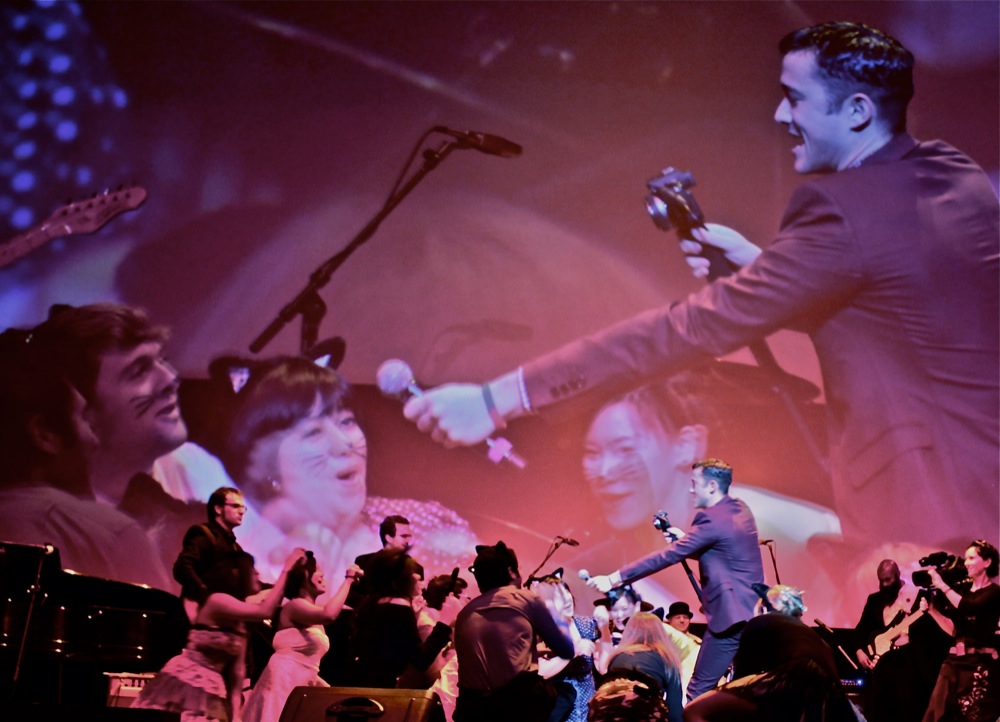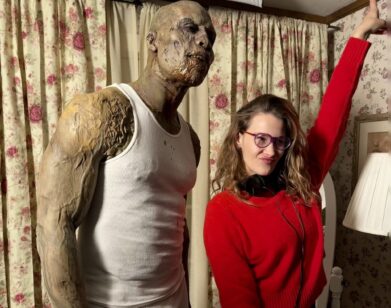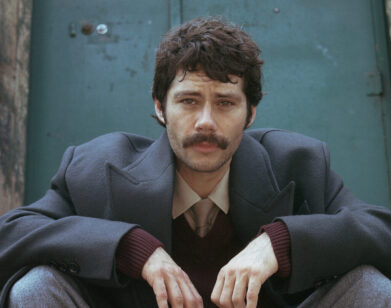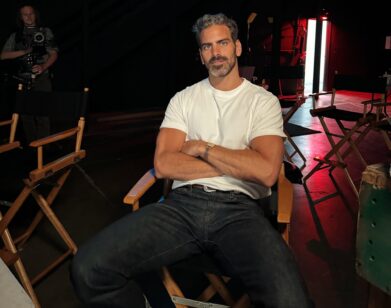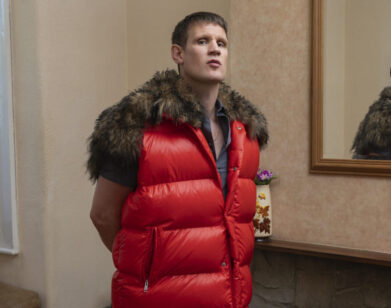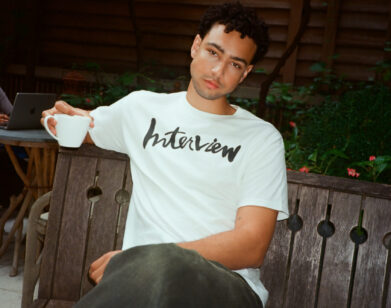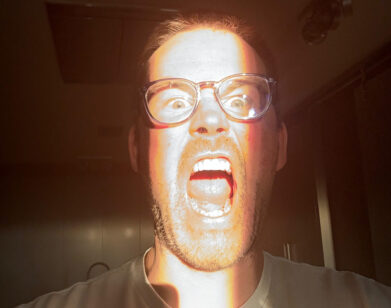A Decade of New Frontier
New Frontier is the future. Each year, helmed by Shari Frilot and Kamal Sinclair, the Sundance Film Festival’s most expansive category exhibits a selection of experimental feature films, shorts, and multimedia projects at various venues across Park City. It is at New Frontier that Joseph Gordon-Levitt debuted his crowd-sourced variety show hitRECord, that James Franco explored rumors of lost deleted footage from the 1980 film Cruising in Interior. Leather Bar, and that visual artist Doug Aitken became a Sundance fixture. It is also out of New Frontier that the Oculus Rift developed and major studios like Fox began experimenting with virtual reality (last year in a companion piece to Wild; this year in a piece bringing the viewer in the world of the box office hit The Martian).
The aim of New Frontier’s diverse programming is both simple and extremely ambitious: to expand and constantly reinvigorate the language of storytelling. “Our everyday life has become a fully immersive media installation,” explains Frilot, who began her career as an experimental filmmaker. “Everywhere we go, there are cameras, there are screens, they’re in our pockets, our automobiles. They’re not necessarily purposed for art and cinematic expression, but New Frontier is built to lay a stake in our contemporary environment to take on this capacity, this media of landscape and purpose it for art and art expression,” she continues. “It is about building an exhibition for the cinematic expression that resonates with our everyday life.”
This year, to celebrate its 10th anniversary, New Frontier will present its most expansive program to date, featuring installations by Chris Milk, Kendrick Lamar and Kahlil Joseph, and Kalup Linzy; VR presentations by Lucy Walker, Nonny de la Peña, and Felix and Paul, among others; and a new socialized form of VR. Later in the year, New Frontier exhibitions will also be on view at MoMA in New York City (April), and the Walker Art Center in Minneapolisâ??(June).
EMMA BROWN: You joined Sundance in 1998. Did you start as a programmer?
SHARI FRILOT: Yes, they made me a programmer. I moved to New York after I went to college in Cambridge [Massachussetts], and I started a festival called MIX. That took me around to the festival circuit and landed me on a panel with [Sundance Film Festival Director] John Cooper. That’s how I met him. When I moved to L.A., Outfest was the other festival that he was working on—he was the director of programming there. He found out that I came to L.A. and hired me as a programmer there, and then hired me for Sundance after that.
BROWN: You’ve talked about going to film festivals as a filmmaker early on in your career, and feeling really frustrated with the experience because you were always put in the same category.
FRILOT: That’s what got me into the festival business. As a filmmaker, I was very frustrated with the design of the festivals that I was being selected for. It seemed like a cookie-cutter template that was very limited and didn’t really encourage a conversation that was expansive around the film that I had made. [My film] was about sexuality and gender, but it was about philosophy, and I really got pigeonholed into this identity-only conversation. I was having that experience each festival I showed the film at. When I got to New York and the New York Lesbian and Gay Experimental Film Festival asked me if I wanted to take the festival over—Jim Hubbard and Sarah Schulman—I said, “Well, yeah. I feel like I need to design the festival that I would be really excited about going to as a filmmaker.”
BROWN: When you first started at Sundance, did it already feel like a festival that you would be really excited about as a filmmaker, or has it developed into that since you’ve been working there?
FRILOT: It’s a funny story. At MIX, I was building a program that was an answer to a lack in the field of what was happening in festivals. It was very white, and it was at a time in the early 1990s when New Queer Cinema was emerging. I was feeling like I was part of a pretty large cohort of up-and-coming filmmakers of color that didn’t really feel like they fit in. So part of what I was doing with MIX, in addition to expanding its formal construct in the film festival paradigm, was building a place where people of color could share their work and find a community. It was always in opposition to what had been percolating in the mainstream festival world. So when I moved to L.A., I never thought about Sundance at all. It was never a place that I thought I would land; I thought of myself as being an alternative to what Sundance was. If I ever want back to the festival business—I went to L.A. to get away from festivals, honestly—I thought I would work for Slamdance. But it turns out that Sundance was way more interesting and alternative than Slamdance. There was a place, and I guess a lot of it has to do with John Cooper because of how he thinks about building a certain kind of dialogue within the team that’s contentious and respected. When I got [to Sundance], I felt like an infiltrator. But that was when Sundance was really taking its next step. There are a lot of different aspects to Sundance, and Frontier was the section that they had carved out before I got there to represent what was happening experimentally in American cinema. That is where I found a home in programming. There was a nurturing there. I remember in those early days, people would always tell me: “We hired you because you are really different, Shari, and we really need you to stay different.” And that continues to be a mantra, because it gave me confidence that my voice was an important voice and it was respected and it had a place in a burgeoning independent cinema scene.
BROWN: In past interviews, you’ve said that when New Frontier started, you had to fight with people who wanted to call it an art show. Can you talk about that a bit?
FRILOT: The reason why I really did not want people talking about “art at Sundance” is because what we’re trying to do at New Frontier is to expand cinema culture by bringing together the communities and practices of the art world, of filmmaking, and of emerging technology. Really puncturing holes in the silos of these three worlds and these three creative communities, and bringing them together in the context of a film festival to provide a platform for what ended up being a hotbed of innovation for storytelling. New Frontier is about storytelling. The approach to storytelling is very expansive, very explosive, but it’s designed to talk to the cinematic eye, cinematic sensibility. It is conceptual as much as it also speaks to someone who’s been watching movies all day and then they walk into New Frontier and they see the same language.
BROWN: Do you find the distinction quite clear-cut when you are assessing a project for New Frontier?
FRILOT: It’s pretty clear for me. In my travels, I go to a lot of art events—I go to Venice and I see a lot of really terrific art. Sometimes I do come to a crossroads where I’m in the middle of this really amazing art project and I wonder, “Is this going to translate to the Sundance audience?” That’s the question that I’m always asking. It’s clear, but at the same time the answer is always surprising because New Frontier is a part of bridging these three worlds. It’s listening for the underlying language that a work is employing and the storytelling vocabulary. If it’s something that I feel is accessible, that exists at Sundance, I go with it. There are always risks being taken in this programming. Speaking of Sundance culture, this audience is very demanding and they demand access to the work. When I brought Nonny de la Peña to the Festival with Hunger in L.A., it was a piece that was going to take 15 minutes per person to come and look at, so I was very nervous about pissing a lot of people off. She had made this work in Unity, so in terms of cinematic standards, the animation seemed not as polished as perhaps you would see in our animation program. But being inside of the new technology was what really raised it to the next level. All directors, they think about themselves as creating a world for their audiences, and bringing their audiences into the world that they are creating inside their heads, and what the virtual reality was presenting was a vision and an experience that is just that. The aesthetics were very in the beginning stages, it was out of her media lab, but I immediately saw that directors were going to go bananas when they got inside of the goggles. It’s a golden fleece of storytelling, of what directors want to do.
BROWN: Last year, New Frontier showed a VR short tied to the movie Wild. I know they wanted to do something similar with The Martian. Did that happen?
FRILOT: Yes, we’re showing it. It’s a very different approach. In the land of VR, everything changes by quantum leap every three months. It’s an explosive medium that’s developing right in front of our eyes—not only technologically, but the industry surrounding it. With Wild, they shot something that’s independent of what the movie was with the same actors and the same story world. With The Martian, they’ve purposed some pretty high-level animation to recreate these visual vistas so that you are actually experiencing what Mark Watney did in the movie. You are landing on Mars. You are recovering from a crash. You are in the lab trying to grow potatoes. You are blasting off from the surface of Mars into space in a spaceship that has no roof, and you’re puncturing your glove. You’re actually in the shoes of the character. They’re also bringing haptic elements into it: so you’re sitting in the chair when you’re in the goggles, and the chair is rumbling when you’re in the Rover. It gives the body an experience that corresponds with what you are seeing.
BROWN: New Frontier is about embracing changes in how we tell stories, but do you ever feel resistant to change? How do you deal with that? So many people are resistant to new technology even though they know it’s inevitable.
FRILOT: I am very open to change. I love that I get to talk to you about the earlier parts of my career. I needed to feel the change so that I could have a place, because I didn’t feel like I had a place. So my whole career has been about changing. One of the things that I’m always tuning into is change that makes the culture more capacious, that makes the culture available for a broader participation by a broader number of people and communities, and that will platform a broader number of visions and different kinds of stories. Our society is diverse and that’s our strength. That’s the richness of our humanity, that we’re all so different from one another. A lot of what’s in place in our society doesn’t really tune into that strength and needs to change if we’re going to get better. So I’m very excited about change, but change has to take place in a way that is accessible. It can’t be illogical; it really has to be viscerally acceptable.
BROWN: Do you feel like the goals of New Frontier have changed a lot since it launched 10 years ago?
FRILOT: It has stayed exactly the same. [laughs] It’s kind of crazy to think about New Frontier’s 10th anniversary. I can’t believe it’s been 10 years. It feels still so fresh and new and really urgent for me. We’re still working to bring different kinds of practice and imaginations together, and we’re still trying to be a catalyst for new kinds of storytelling and points of access. Everyone wants to talk about VR, which is amazing, it’s this billion-dollar industry that came out of it, but there were other things too, like Joseph Gordon-Levitt and crowdsourcing storytelling, that happened right at the time when the independent film world became very vulnerable and our economy broke and there was technology available to explore new business models, and an established actor found one of those business models. People like James Franco, New Frontier was there when he wanted to explore things that he wasn’t really involved in at that time to not only platform it, but R and D it, to test it out on audiences. It’s there in the very same way it was in 2007, and I know that that’s true because I’m as scared now as I’ve ever been before a show. I’ve never felt like I’ve nailed it. Every year, I’m scared out of my pants about whether people are going to get the show.
FOR MORE ON THIS YEAR’S NEW FRONTIER PROGRAM, OR THE NEW FRONTIER STORY LABS, VISIT THE SUNDANCE FILM FESTIVAL WEBSITE.

